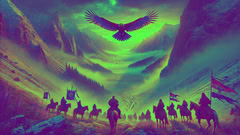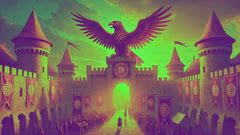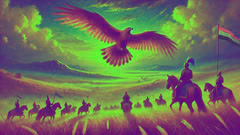Introduction
Long before Hungary was shaped by kings and castles, before the clang of swords echoed in its green valleys, and before the Danube’s winding silver ribbon divided a bustling capital, the Carpathian Basin slumbered beneath a sky where myth and memory blended like morning mist. The grasslands stretched as far as the eye could see—waves of emerald and gold, broken only by ancient forests and distant, snow-flecked peaks. Here, stories grew wild, nourished by the dreams of wandering tribes. Among these stories, one soared above all: the legend of the Turul, a bird as vast as the sky itself, whose wings cast shadows over the fates of nations. The Turul was no ordinary creature. In the collective heart of the Magyar people, it was a guardian, an omen, and the embodiment of hope and destiny. Its mighty wings and keen eyes watched over the Magyars, a restless tribe whose journey across endless steppes became legend. Through thunderous storms and moonlit plains, the Magyars pursued a vision—a promise whispered on the wind, believed to be sent by the gods themselves. And always, high above, the Turul soared, guiding, protecting, and inspiring a people who would one day call the land beneath its wings their own. This is not simply a story of migration or survival; it is the epic of a nation’s birth. It is a tale where reality and myth entwine like roots beneath the soil, where the pulse of history is felt in the beating wings of a mythic bird. To know Hungary, to understand the Magyar soul, one must look up—far above the misty plains and deep forests—to where the Turul glides in the eternal sky.
Whispers on the Steppe: The Call to Journey
In the days when the world was young and the stars hung low over the boundless Eurasian steppe, the Magyar people lived in a tapestry of shifting camps and fluttering tents. Their lives were woven with the rhythm of horses’ hooves, the laughter of children, and the haunting melodies sung beside crackling fires. Yet, despite the beauty of their homeland, an uneasy restlessness stirred in the hearts of the Magyar chieftains. They were a people shaped by the wind, their destiny unsettled as the grass beneath their feet.

Among them was Emese, wife to Ügyek, a noble descendant of Attila’s own bloodline. Emese was revered for her wisdom and for the gentle strength in her gaze, which seemed to see beyond what others could. One night, as thunder rumbled across the horizon and the wind whispered secrets through the tent flaps, Emese dreamed a dream that would alter the course of history.
In her vision, a colossal bird—its wings wider than rivers, its eyes bright as stars—descended from the sky. The Turul, revered in ancient Magyar lore as a messenger of the gods, hovered above her, powerful and serene. Its feathers shimmered in hues no weaver could reproduce, and its talons gripped a gleaming sword. With a voice that echoed like distant thunder, the Turul spoke: “From you shall spring forth a line of kings, and your people will find their true home beyond the mountains where the rivers meet.”
When Emese awoke, the dream lingered in her mind like the aftertaste of wild honey. She confided in Ügyek, who summoned the chieftains to council. Around the sacred fire, as flames licked the night, Emese recounted her vision. The elders listened, their faces carved with concern and awe. Dreams were not taken lightly among the Magyars, and the Turul was no mere symbol—it was fate itself.
As days passed, rumors of Emese’s dream rippled across the steppe. It was said that wherever her son, Álmos, would be born, the fate of the people would follow. The Turul became a sign, appearing in sudden storms and in flocks of birds wheeling above the camps. Warriors painted its image on their shields, mothers sang its name in lullabies, and elders watched the skies for its shadow. The tribe’s wise men read omens in bird flight, and all agreed: the time to journey had come.
The Magyars packed their belongings and set forth. Herds of horses, cattle, and sheep moved as one, their hooves drumming the earth. Children clung to their mothers as the horizon shifted. The Turul’s legend was now their compass. Sometimes, when spirits flagged and uncertainty gnawed at them, a solitary hawk would appear against the sun, igniting hope in weary hearts. Some swore they saw a larger, more radiant bird—a vision both awe-inspiring and terrifying. For the Magyars, it was proof their journey was divinely guided.
The path was fraught with hardship: storms battered the travelers; hostile tribes eyed them from afar; rivers swelled with spring melt, threatening to sweep away entire families. Yet the Magyars pressed on, their songs weaving tales of courage and endurance. Through each trial, they found reassurance in the Turul’s silent presence. It was in these early days that Álmos was born—cradled under an open sky, his birth greeted by the cry of a bird that sent shivers down the spines of every elder present.
The birth of Álmos signaled a new beginning. As the boy grew, so did the legend of the Turul. It was whispered that the bird visited him in dreams, teaching him the names of rivers he had never seen, the shape of mountains that lay far to the west, and the promise of a land where the Magyars would flourish. The journey continued, but now there was purpose—a belief that the Turul’s guidance would one day bring them home.
Crossing Mountains: Ordeal and Revelation
The Magyars’ migration spanned years—years in which legends mingled with hardship. The journey took them through endless grasslands, across stormy rivers, and into foreboding forests where light filtered green and gold through ancient boughs. They skirted the lands of hostile tribes, sometimes clashing, sometimes forging uneasy truces. The promise of the Turul sustained them, but every step westward seemed to demand a toll of sacrifice.

As Álmos came of age, his presence steadied the people. He grew tall and quiet, his eyes always drawn to the horizon or to the sky above. Elders noted how hawks and falcons circled above him more often than any other youth. Some whispered that he carried the Turul’s blessing in his blood. Álmos listened to stories and observed the world with a thoughtful intensity, learning to guide not only horses but hearts. His bond with the Turul deepened in dreams where he soared over mountains and rivers unseen by waking eyes.
The journey’s greatest ordeal came as the Magyars approached the Carpathian Mountains—a vast barrier of stone and forest that loomed between them and the land promised in Emese’s vision. Many among the tribe despaired. The mountain passes were treacherous, shrouded in mist and echoing with the howls of wolves. Some wanted to turn back, convinced they’d been led astray by a phantom. Others remembered the Turul’s prophecy and pressed on.
It was then, as hope frayed like old cloth, that Álmos summoned the chieftains to a midnight council. Beneath a sky alive with stars, he spoke of his dreams: “Last night, the Turul perched upon a stone at the mountain’s foot and beckoned me to follow. Its cry was not of warning, but of welcome. We must trust in its guidance.”
At dawn, as they prepared to enter the mountain pass, a great commotion rippled through the camp. Children pointed skyward in awe—a vast bird, brighter than gold, soared overhead. Its wings blazed in the morning light, its call echoing through stone valleys. Warriors fell to their knees; elders wept. The Turul led the way.
Following the bird’s flight, the Magyars found a hidden path through the mountains—narrow and perilous but safe from landslides and ambush. For days, they moved as one, shadows flickering over snow-dusted peaks. The Turul’s shadow passed over them, its cry carrying on the wind, urging them forward. At night, Álmos dreamed of standing atop a high ridge, gazing down on a land bursting with rivers and meadows. The Turul rested on his shoulder—a sign that the end was near.
On the seventh day, the tribe emerged from the mountain pass and gazed upon a valley lush with wildflowers, watered by twin rivers that sparkled in the sun. The land was more beautiful than any tale; it seemed untouched by war or sorrow. The Turul circled overhead, then vanished into the clouds, its duty fulfilled for now. The Magyars wept with gratitude. Here, they believed, was the home promised by prophecy—a place their descendants would call Magyarország.
But the journey had transformed them. They’d crossed not only mountains but the threshold from wandering tribe to nascent nation. The Turul’s legend became the heart of their story—a symbol of courage, unity, and hope reborn.
Founding of a Nation: The Turul’s Legacy
Settlement in the Carpathian Basin was not the end of the Magyars’ trials but the beginning of a new chapter—one where legend and history became inseparable. The land itself felt enchanted: dense forests teemed with deer and boar; rivers teemed with fish; fields yielded wheat as golden as the Turul’s plumage. The Magyars raised their tents along riverbanks and built wooden palisades to mark their villages. They honored the Turul in every corner: its likeness adorned banners and shields, carved into wood and stone, stitched into garments. It became a sign not only of what they had endured, but of what they hoped to achieve.

Álmos, now a leader recognized by all tribes, convened a great assembly beneath an ancient oak. Here he recounted the journey—the hardships faced, the courage summoned, and the faith kept alive by the Turul’s guidance. He declared, “Let this bird be the guardian of our people and our land, its wings sheltering us from harm.” The Magyars cheered, planting their standards deep into the earth. Songs arose that night—songs of rivers crossed, mountains conquered, and skies forever watched by their sacred bird.
Yet even as peace flourished, danger lingered beyond the horizon. Neighboring peoples eyed the fertile basin with envy, and rumors of invading armies drifted in with the changing winds. Once again, it was said, the Turul appeared in dreams to Álmos’s son, Árpád—now a chieftain in his own right. The bird’s message was clear: unity would be their greatest strength. Under Árpád’s guidance, the Magyars forged new alliances among the tribes, blending ancient customs with new laws. They built fortified settlements and trained warriors who bore the Turul’s image on their shields.
The legend grew. When foes threatened, it was believed that the Turul’s cry would ring out before dawn, rousing sentinels and warning of danger. In times of famine, a lone hawk might appear at dusk, a sign that hope had not abandoned them. Children learned to recognize the shadow of a soaring bird as a good omen. Priests and storytellers embroidered new tales onto the old—of battles won by cunning as much as by steel, of peace brokered beneath wings outstretched.
Generations passed. The Magyars’ bond with the land deepened; their language and customs flourished. The Turul became more than a symbol—it became the spirit of Hungary itself. Its likeness was cast in bronze atop castle gates and etched into royal seals. It watched over coronations and funerals, over festivals and wars. Each time the nation faced peril or doubt, the people looked skyward for their guardian.
In this way, the legend of the Turul endured—not only as a story told around fires or inscribed in ancient chronicles, but as a living part of Hungary’s soul. Its message remained unchanged: courage in adversity, unity in purpose, and hope that soars on unbreakable wings.
Conclusion
The legend of the Turul is woven into every thread of Hungarian identity—a myth that echoes across centuries from grassy plains to bustling cities, from ancient oak groves to proud stone castles. It’s a reminder that nations are not forged by chance alone, but by courage, unity, and faith in something greater than themselves. The Magyars’ journey across the steppe was shaped as much by hardship as by hope; their survival depended on trust in visions and the wisdom to heed omens. Through it all, the Turul soared—sometimes seen, sometimes only felt—a silent witness and guide. Today, as the Turul’s image graces monuments and inspires stories, its wings still shelter a people who once followed it across an unending horizon, believing that destiny awaited where earth and sky meet. Hungary’s heart beats to the rhythm of those mighty wings—an eternal symbol that even in the darkest times, hope can rise and lead us home.













